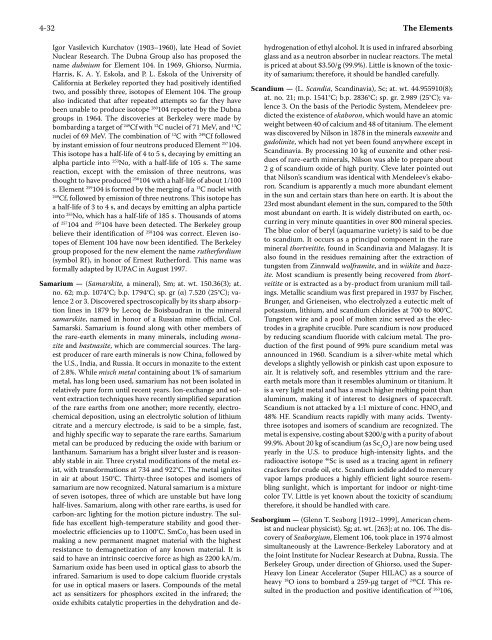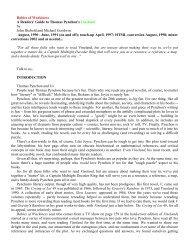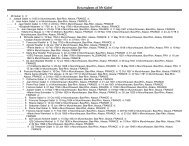CRC Handbook of Chemistry and Physics, 86th Edition
CRC Handbook of Chemistry and Physics, 86th Edition
CRC Handbook of Chemistry and Physics, 86th Edition
You also want an ePaper? Increase the reach of your titles
YUMPU automatically turns print PDFs into web optimized ePapers that Google loves.
4-32 The Elements<br />
Igor Vasilevich Kurchatov (1903–1960), late Head <strong>of</strong> Soviet<br />
Nuclear Research. The Dubna Group also has proposed the<br />
name dubnium for Element 104. In 1969, Ghiorso, Nurmia,<br />
Harris, K. A. Y. Eskola, <strong>and</strong> P. L. Eskola <strong>of</strong> the University <strong>of</strong><br />
California at Berkeley reported they had positively identified<br />
two, <strong>and</strong> possibly three, isotopes <strong>of</strong> Element 104. The group<br />
also indicated that after repeated attempts so far they have<br />
been unable to produce isotope 260 104 reported by the Dubna<br />
groups in 1964. The discoveries at Berkeley were made by<br />
bombarding a target <strong>of</strong> 249 Cf with 12 C nuclei <strong>of</strong> 71 MeV, <strong>and</strong> 13 C<br />
nuclei <strong>of</strong> 69 MeV. The combination <strong>of</strong> 12 C with 249 Cf followed<br />
by instant emission <strong>of</strong> four neutrons produced Element 257 104.<br />
This isotope has a half-life <strong>of</strong> 4 to 5 s, decaying by emitting an<br />
alpha particle into 253 No, with a half-life <strong>of</strong> 105 s. The same<br />
reaction, except with the emission <strong>of</strong> three neutrons, was<br />
thought to have produced 258 104 with a half-life <strong>of</strong> about 1/100<br />
s. Element 259 104 is formed by the merging <strong>of</strong> a 13 C nuclei with<br />
249 Cf, followed by emission <strong>of</strong> three neutrons. This isotope has<br />
a half-life <strong>of</strong> 3 to 4 s, <strong>and</strong> decays by emitting an alpha particle<br />
into 255 No, which has a half-life <strong>of</strong> 185 s. Thous<strong>and</strong>s <strong>of</strong> atoms<br />
<strong>of</strong> 257 104 <strong>and</strong> 259 104 have been detected. The Berkeley group<br />
believe their identification <strong>of</strong> 258 104 was correct. Eleven isotopes<br />
<strong>of</strong> Element 104 have now been identified. The Berkeley<br />
group proposed for the new element the name rutherfordium<br />
(symbol Rf), in honor <strong>of</strong> Ernest Rutherford. This name was<br />
formally adapted by IUPAC in August 1997.<br />
Samarium — (Samarskite, a mineral), Sm; at. wt. 150.36(3); at.<br />
no. 62; m.p. 1074°C; b.p. 1794°C; sp. gr (α) 7.520 (25°C); valence<br />
2 or 3. Discovered spectroscopically by its sharp absorption<br />
lines in 1879 by Lecoq de Boisbaudran in the mineral<br />
samarskite, named in honor <strong>of</strong> a Russian mine <strong>of</strong>ficial, Col.<br />
Samarski. Samarium is found along with other members <strong>of</strong><br />
the rare-earth elements in many minerals, including monazite<br />
<strong>and</strong> bastnasite, which are commercial sources. The largest<br />
producer <strong>of</strong> rare earth minerals is now China, followed by<br />
the U.S., India, <strong>and</strong> Russia. It occurs in monazite to the extent<br />
<strong>of</strong> 2.8%. While misch metal containing about 1% <strong>of</strong> samarium<br />
metal, has long been used, samarium has not been isolated in<br />
relatively pure form until recent years. Ion-exchange <strong>and</strong> solvent<br />
extraction techniques have recently simplified separation<br />
<strong>of</strong> the rare earths from one another; more recently, electrochemical<br />
deposition, using an electrolytic solution <strong>of</strong> lithium<br />
citrate <strong>and</strong> a mercury electrode, is said to be a simple, fast,<br />
<strong>and</strong> highly specific way to separate the rare earths. Samarium<br />
metal can be produced by reducing the oxide with barium or<br />
lanthanum. Samarium has a bright silver luster <strong>and</strong> is reasonably<br />
stable in air. Three crystal modifications <strong>of</strong> the metal exist,<br />
with transformations at 734 <strong>and</strong> 922°C. The metal ignites<br />
in air at about 150°C. Thirty-three isotopes <strong>and</strong> isomers <strong>of</strong><br />
samarium are now recognized. Natural samarium is a mixture<br />
<strong>of</strong> seven isotopes, three <strong>of</strong> which are unstable but have long<br />
half-lives. Samarium, along with other rare earths, is used for<br />
carbon-arc lighting for the motion picture industry. The sulfide<br />
has excellent high-temperature stability <strong>and</strong> good thermoelectric<br />
efficiencies up to 1100°C. SmCo 5 has been used in<br />
making a new permanent magnet material with the highest<br />
resistance to demagnetization <strong>of</strong> any known material. It is<br />
said to have an intrinsic coercive force as high as 2200 kA/m.<br />
Samarium oxide has been used in optical glass to absorb the<br />
infrared. Samarium is used to dope calcium fluoride crystals<br />
for use in optical masers or lasers. Compounds <strong>of</strong> the metal<br />
act as sensitizers for phosphors excited in the infrared; the<br />
oxide exhibits catalytic properties in the dehydration <strong>and</strong> de-<br />
hydrogenation <strong>of</strong> ethyl alcohol. It is used in infrared absorbing<br />
glass <strong>and</strong> as a neutron absorber in nuclear reactors. The metal<br />
is priced at about $3.50/g (99.9%). Little is known <strong>of</strong> the toxicity<br />
<strong>of</strong> samarium; therefore, it should be h<strong>and</strong>led carefully.<br />
Sc<strong>and</strong>ium — (L. Sc<strong>and</strong>ia, Sc<strong>and</strong>inavia), Sc; at. wt. 44.955910(8);<br />
at. no. 21; m.p. 1541°C; b.p. 2836°C; sp. gr. 2.989 (25°C); valence<br />
3. On the basis <strong>of</strong> the Periodic System, Mendeleev predicted<br />
the existence <strong>of</strong> ekaboron, which would have an atomic<br />
weight between 40 <strong>of</strong> calcium <strong>and</strong> 48 <strong>of</strong> titanium. The element<br />
was discovered by Nilson in 1878 in the minerals euxenite <strong>and</strong><br />
gadolinite, which had not yet been found anywhere except in<br />
Sc<strong>and</strong>inavia. By processing 10 kg <strong>of</strong> euxenite <strong>and</strong> other residues<br />
<strong>of</strong> rare-earth minerals, Nilson was able to prepare about<br />
2 g <strong>of</strong> sc<strong>and</strong>ium oxide <strong>of</strong> high purity. Cleve later pointed out<br />
that Nilson’s sc<strong>and</strong>ium was identical with Mendeleev’s ekaboron.<br />
Sc<strong>and</strong>ium is apparently a much more abundant element<br />
in the sun <strong>and</strong> certain stars than here on earth. It is about the<br />
23rd most abundant element in the sun, compared to the 50th<br />
most abundant on earth. It is widely distributed on earth, occurring<br />
in very minute quantities in over 800 mineral species.<br />
The blue color <strong>of</strong> beryl (aquamarine variety) is said to be due<br />
to sc<strong>and</strong>ium. It occurs as a principal component in the rare<br />
mineral thortveitite, found in Sc<strong>and</strong>inavia <strong>and</strong> Malagasy. It is<br />
also found in the residues remaining after the extraction <strong>of</strong><br />
tungsten from Zinnwald wolframite, <strong>and</strong> in wiikite <strong>and</strong> bazzite.<br />
Most sc<strong>and</strong>ium is presently being recovered from thortveitite<br />
or is extracted as a by-product from uranium mill tailings.<br />
Metallic sc<strong>and</strong>ium was first prepared in 1937 by Fischer,<br />
Brunger, <strong>and</strong> Grieneisen, who electrolyzed a eutectic melt <strong>of</strong><br />
potassium, lithium, <strong>and</strong> sc<strong>and</strong>ium chlorides at 700 to 800°C.<br />
Tungsten wire <strong>and</strong> a pool <strong>of</strong> molten zinc served as the electrodes<br />
in a graphite crucible. Pure sc<strong>and</strong>ium is now produced<br />
by reducing sc<strong>and</strong>ium fluoride with calcium metal. The production<br />
<strong>of</strong> the first pound <strong>of</strong> 99% pure sc<strong>and</strong>ium metal was<br />
announced in 1960. Sc<strong>and</strong>ium is a silver-white metal which<br />
develops a slightly yellowish or pinkish cast upon exposure to<br />
air. It is relatively s<strong>of</strong>t, <strong>and</strong> resembles yttrium <strong>and</strong> the rareearth<br />
metals more than it resembles aluminum or titanium. It<br />
is a very light metal <strong>and</strong> has a much higher melting point than<br />
aluminum, making it <strong>of</strong> interest to designers <strong>of</strong> spacecraft.<br />
Sc<strong>and</strong>ium is not attacked by a 1:1 mixture <strong>of</strong> conc. HNO 3 <strong>and</strong><br />
48% HF. Sc<strong>and</strong>ium reacts rapidly with many acids. Twentythree<br />
isotopes <strong>and</strong> isomers <strong>of</strong> sc<strong>and</strong>ium are recognized. The<br />
metal is expensive, costing about $200/g with a purity <strong>of</strong> about<br />
99.9%. About 20 kg <strong>of</strong> sc<strong>and</strong>ium (as Sc 2 O 3 ) are now being used<br />
yearly in the U.S. to produce high-intensity lights, <strong>and</strong> the<br />
radioactive isotope 46 Sc is used as a tracing agent in refinery<br />
crackers for crude oil, etc. Sc<strong>and</strong>ium iodide added to mercury<br />
vapor lamps produces a highly efficient light source resembling<br />
sunlight, which is important for indoor or night-time<br />
color TV. Little is yet known about the toxicity <strong>of</strong> sc<strong>and</strong>ium;<br />
therefore, it should be h<strong>and</strong>led with care.<br />
Seaborgium — (Glenn T. Seaborg [1912–1999], American chemist<br />
<strong>and</strong> nuclear physicist). Sg; at. wt. [263]; at no. 106. The discovery<br />
<strong>of</strong> Seaborgium, Element 106, took place in 1974 almost<br />
simultaneously at the Lawrence-Berkeley Laboratory <strong>and</strong> at<br />
the Joint Institute for Nuclear Research at Dubna, Russia. The<br />
Berkeley Group, under direction <strong>of</strong> Ghiorso, used the Super-<br />
Heavy Ion Linear Accelerator (Super HILAC) as a source <strong>of</strong><br />
heavy 18 O ions to bombard a 259-µg target <strong>of</strong> 249 Cf. This resulted<br />
in the production <strong>and</strong> positive identification <strong>of</strong> 263 106,







